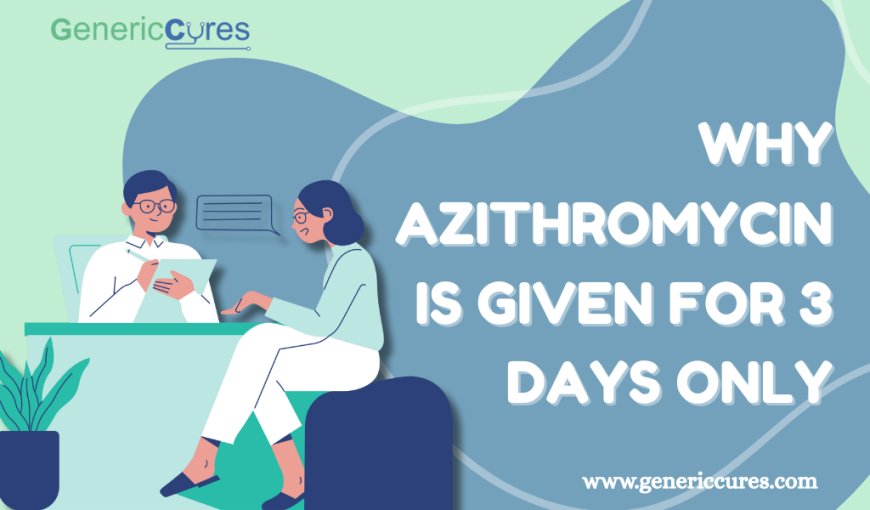Why Azithromycin Is Given for 3 Days Only

When you visit your doctor for a bacterial infection, they might prescribe Azithromycinan antibiotic commonly used to treat conditions like sinus infections, bronchitis, strep throat, and even sexually transmitted infections. What often surprises people is that this antibiotic is prescribed for just 3 days, unlike many others that require a full week or longer. So, why is Azithromycin given for 3 days only?
What Is Azithromycin?
Azithromycin is a macrolide antibiotic that works by inhibiting bacterial protein synthesis, effectively stopping the growth of bacteria. Its known for treating a wide range of infections including:
-
Respiratory tract infections
-
Ear and throat infections
-
Skin infections
-
Sexually transmitted diseases
-
Certain gastrointestinal infections
One of the most recognized formulations is Azipro 500 mg, which delivers a high concentration of Azithromycin per dose, making it suitable for once-daily treatment.
Why Azithromycin Is Prescribed for Just 3 Days
Most antibiotics require a 7 to 10-day course to fully eradicate bacterial infections. However, Azithromycin behaves differently due to its unique pharmacokinetics and mechanism of action.
Heres why a 3-day course is effective:
1. Long Half-Life
Azithromycin has a very long half-life (up to 68 hours), meaning it stays in the body and continues working well after the last dose. Even when the last tablet is taken, the drug remains active in the bloodstream for up to 57 days, slowly clearing out.
This allows Azithromycin to continue fighting bacteria without needing additional doses beyond the initial 3 days.
2. High Tissue Penetration
Another reason Azithromycin is effective over a short period is its high tissue penetration. Once ingested, the drug accumulates in infected tissues where it exerts its effects for an extended time. This makes it particularly effective for respiratory tract infections and skin infections, where localized treatment is vital.
3. Post-Antibiotic Effect (PAE)
Azithromycin exhibits a post-antibiotic effect, meaning its antibacterial activity continues even after blood levels decrease. This is a rare property not seen in many antibiotics and is key to its short-duration therapy.
Typical Dosage: Azithromycin 500mg for 3 Days
A common prescription is Azithromycin 500mg for 3 days. Patients are instructed to take one tablet daily for three consecutive days, after which no further doses are needed.
This regimen is clinically proven to be effective for mild to moderate infections such as:
-
Community-acquired pneumonia
-
Acute sinusitis
-
Bronchitis
-
Streptococcal pharyngitis
-
Skin and soft tissue infections
Remember, its crucial to complete the full courseeven if symptoms improve earlierto ensure the infection is fully eradicated and prevent antibiotic resistance.
Benefits of the 3-Day Course
The short 3-day treatment with Azithromycin offers several advantages over longer courses of other antibiotics:
1. Better Patient Compliance
Fewer doses mean patients are more likely to complete the course, leading to better treatment outcomes and fewer chances of resistance.
2. Lower Risk of Side Effects
With a shorter exposure time, patients are less likely to experience side effects such as gastrointestinal discomfort, nausea, or allergic reactions.
3. Convenient for Busy Schedules
People with busy lifestyles or limited access to healthcare facilities find short-duration therapy much more manageable.
When Is a Longer Course Needed?
In some cases, a longer course of Azithromycin may be requiredparticularly for chronic infections or those involving multiple systems. Doctors might extend the treatment to 5 or even 10 days depending on:
-
Severity of infection
-
Patients immune status
-
Response to initial treatment
However, for most uncomplicated infections, the 3-day course remains the gold standard.
Safety and Side Effects of Azithromycin
Like all medications, Azithromycin can cause side effects. These are usually mild and go away on their own:
-
Diarrhea
-
Nausea
-
Abdominal cramps
-
Headache
-
Dizziness
In rare cases, severe allergic reactions or irregular heart rhythms can occur. Always consult a doctor if symptoms persist or worsen.
Where to Safely Buy Azithromycin
If your doctor has prescribed Azithromycin, its important to purchase it from a reliable and certified source. Platforms like Genericcuresoffer genuine medications, including Azithromycin, with proper dosage information and discreet shipping.
Consumers seeking to buy azithromycin online should prioritize safety, authenticity, and regulatory approval. Avoid self-medication and always follow professional guidance.
How Azithromycin Compares to Other Antibiotics
Azithromycin's long-lasting effect and convenient dosing make it one of the most preferred antibiotics among healthcare providers. Heres how it compares to other commonly used antibiotics:
| Feature | Azithromycin | Amoxicillin | Doxycycline |
|---|---|---|---|
| Duration of therapy | 3 days | 710 days | 714 days |
| Daily doses | 1 | 23 | 12 |
| Post-antibiotic effect | Yes | No | Yes |
| Best for | Respiratory, skin, STDs | Ear, dental, sinus | Acne, Lyme disease |
Tips for Taking Azithromycin
To ensure maximum effectiveness:
-
Take on an empty stomach (1 hour before or 2 hours after food) unless directed otherwise.
-
Do not skip doses. Take the medication at the same time each day.
-
Avoid antacids within 2 hours of taking Azithromycin, as they can interfere with absorption.
-
Drink plenty of fluids to stay hydrated during the course.
Final Thoughts: A Powerful Antibiotic in a Short Package
Azithromycin is a versatile and highly effective antibiotic that works efficiently with just 3 days of treatment. Thanks to its long half-life, post-antibiotic effect, and excellent tissue penetration, it continues to provide antibacterial action long after the last dose.
Its 3-day regimen improves patient adherence, reduces side effects, and minimizes resistance when used responsibly.
Always use Azithromycin as prescribed, and purchase from trusted providers to ensure quality and safety.



































